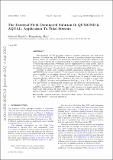Files in this item
The external field dominated solution in QUMOND and Aqual : application to tidal streams
Item metadata
| dc.contributor.author | Banik, Indranil | |
| dc.contributor.author | Zhao, Hongsheng | |
| dc.date.accessioned | 2018-07-09T08:30:06Z | |
| dc.date.available | 2018-07-09T08:30:06Z | |
| dc.date.issued | 2018-06-01 | |
| dc.identifier.citation | Banik , I & Zhao , H 2018 , ' The external field dominated solution in QUMOND and Aqual : application to tidal streams ' , ArXiv e-prints . < https://arxiv.org/abs/1509.08457v3 > | en |
| dc.identifier.other | PURE: 245838130 | |
| dc.identifier.other | PURE UUID: 059f0f23-35d4-4ebf-8ab4-cf7684034bdc | |
| dc.identifier.other | ArXiv: http://arxiv.org/abs/1509.08457v1 | |
| dc.identifier.other | ORCID: /0000-0002-4123-7325/work/46362253 | |
| dc.identifier.uri | https://hdl.handle.net/10023/15085 | |
| dc.description.abstract | The standard ΛCDM paradigm seems to describe cosmology and large scale structure formation very well. However, a number of puzzling observations remain on galactic scales. An example is the anisotropic distribution of satellite galaxies in the Local Group. This has led to suggestions that a modified gravity theory might provide a better explanation than Newtonian gravity supplemented by dark matter. One of the leading modified gravity theories is Modified Newtonian Dynamics (MOND). For an isolated point mass, it boosts gravity by an acceleration-dependent factor of ν. Recently, a much more computer-friendly quasi-linear formulation of MOND (QUMOND) has become available. We investigate analytically the solution for a point mass embedded in a constant external field of g ext. We find that the potential is Φ = - GM/(rνext) (1 + 1/2 K0 sin2θ), where r is distance from the mass M which is in an external field that ‘saturates’ the ν function at the value νext, leading to a fixed value of K0 ≡ ∂Ln(ν)/∂Ln(gext). In a very weak gravitational field (| g ext| « a0), K0 = -1/2. The angle θ is that between the external field direction and the direction towards the mass. Our results are quite close to the more traditional aquadratic Lagrangian (AQUAL) formulation of MOND. We apply both theories to a simple model of the Sagittarius tidal stream. We find that they give very similar results, with the tidal stream seeming to spread slightly further in AQUAL. | |
| dc.format.extent | 5 | |
| dc.language.iso | eng | |
| dc.relation.ispartof | ArXiv e-prints | en |
| dc.rights | Copyright (c) 2018 The authors. This preprint is available under a Creative Commons Attribution Licence (http://creativecommons.org/licenses/by/4.0/) | en |
| dc.subject | Galaxies: individual: Sagittarius dSph | en |
| dc.subject | Galaxy: kinematics and dynamics | en |
| dc.subject | Dark matter | en |
| dc.subject | Methods: numerical | en |
| dc.subject | QB Astronomy | en |
| dc.subject | QC Physics | en |
| dc.subject | Astronomy and Astrophysics | en |
| dc.subject | NDAS | en |
| dc.subject.lcc | QB | en |
| dc.subject.lcc | QC | en |
| dc.title | The external field dominated solution in QUMOND and Aqual : application to tidal streams | en |
| dc.type | Journal article | en |
| dc.description.version | https://doi.org/Preprint | en |
| dc.contributor.institution | University of St Andrews. School of Physics and Astronomy | en |
| dc.description.status | Peer reviewed | en |
| dc.identifier.url | http://arxiv.org/abs/1509.08457 | en |
| dc.identifier.url | https://arxiv.org/abs/1509.08457v3 | en |
This item appears in the following Collection(s)
Items in the St Andrews Research Repository are protected by copyright, with all rights reserved, unless otherwise indicated.

